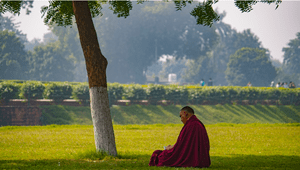
There are many denominations, and even sub-denominations, of Buddhism—and a variety of different orders of monasticism. While there are aspects of the process of becoming a Buddhist monk that are similar, there are also many differences in the process and even in the vows taken. Below, we will outline some commonalities. However, if one is genuinely considering ordination, one should consult with the tradition and specific sangha into which one would be ordained, in order to ascertain requirements, timeframe, and the extent of the commitments one makes.
Study
Knowledge is crucial. Traditionally, monks not only help others on their path to greater spirituality, and serve the community around them, but they also teach the history and tenets of Buddhism to others—something you cannot do if you do not have a through understanding of the tradition you are seeking to be ordained into. Additionally, because there are many denominations of Buddhism, your studies will help you to select the right type of Buddhism and the right monastic order to match your spiritual needs and your goals in becoming a monastic.
Sangha
The word sangha means “community.” Early in Buddhist history, sanghas were not for lay believers, but specifically for practicing monastics. However, today, a sangha can be a community of monks (bhikkhu) or nuns (bhikkhuni), but it may also include novices (preparing for ordination) as well as being a term which refers to a group of lay Buddhists. If one is sincerely contemplating ordination, joining a sangha or temple and living the Vinaya (or “discipline”/rules) is not just advisable, but very helpful. In doing so, one will gain the guidance one needs to make a proper decision as to whether to actually seek ordination. As you practice (as part of a sangha), you will have a greater sense of what you would be required to embrace and let go of, were you to become an ordained monk.
Guide
In many religious traditions—including, but not limited to the Asian religious traditions—the concept of being tutored by a spiritual guide, guru, or mentor is common. In many Buddhist traditions, one selects a spiritual mentor to guide the novice along the path of understanding, heightened spirituality, and practice. In Buddhist monasticism, this is an important practice. Some sanghas will assign a mentor to a novice, while others will encourage the novitiate to seek out someone to be his spiritual guide. Either way, monasticism is not a path one should pursue alone. You will need to be taught, and those who have already traveled the path to ordination can help you in your preparations.
Engage
Becoming a Buddhist monk is a bit more complex than what’s offered by some online ministerial websites—where, for a “one time filing fee of $25,” one can claim “ordination” and now perform marriages and other ecclesiastical functions “in less than 48 hours.” Generally speaking, becoming a Buddhist monk is not something you do overnight. Prior to being ordained, most Buddhists study and engage in spiritual preparation for several years. There is much to learn, from controlling one’s thoughts (perhaps through meditative practice) to mastering one’s physical appetites. Understanding and being prepared to keep the vows one will take upon oneself is also something that requires time and preparation. (Different sanghas or abbeys will have different requirements.) Living a life largely free of worldly attachments can be a remarkably hard lifestyle change to make. Thus, fully immersing oneself in the way of life, engaging in the practice, and loving the ways of a monastic are important prior to ordination.
Commitment
Some monastic traditions require a life-long commitment for those who seek ordination. That is the most common route. However, today, there are actually Buddhist sanghas that allow one to take vows that are limited in their duration. These are frequently seen as vows dedicated to “character transformation,” and last anywhere from a few months to a few years. Thai Buddhism actually has ordinations that last from one week to three months! But, again, these are exceptions, not the norm. One thing one must decide early in the process is whether one is “up for” a life of full monastic dedication. This decision is much more daunting than a few months or a few years of celibacy and cellphone sacrifice. Thus, the degree one is committed to this new life and its associated vows is an important decision that needs to be made with “eyes wide open.”
Sacrifice
Significant sacrifice is required of those who pursue a life of monasticism. We’ve already suggested above that most Buddhist monastics live lives of celibacy. In addition, many of the “creature comforts,” such as “luxury items,” are also forbidden. In the vast majority of sanghas, monastics do not partake of secular entertainment, surf the internet, or wear the common clothes of the laity. Interaction with one’s birth family is sometimes limited, as the members of one’s monastic community become one’s new “family.” Thus, one must be willing to let go of one's past life, in most cases, in order to begin this “new life” as a monk.
Ordination
The actual rite of ordination—the “going forth,” as it is known—varies from tradition to tradition. Buddhism is complex and, therefore, there isn’t a single rite of ordination for Buddhist monks. In Theravada and Mahayana traditions, there are two ordinations a monk participates in: the initial ordination as a “novice” (which is often performed without great fanfare, tough with several liturgical steps), and the final or “higher ordination,” when one becomes a full-fledged monk, which is traditionally a much more public event, with many in attendance.
The higher ordination is usually a celebratory occasion. Sometimes a festive parade is held. Family and close friends are traditionally invited, and this is often the last bit of frequent contact a monk with have with those individuals after his ordination. After the ordination, some distance is placed between the monastic and family/friends as a means of limiting attachment and enabling focus on spiritual pursuits.
While there is one ceremony for the novice’s ordination (called pabbajja) and another for higher ordination (or the final ordination, known as upasaṃpadā), we will focus on the latter here. Traditionally, those being ordained have had their head shaved since the time of their novitiate vows. The novice approaches the senior monk, bows thrice, and then kneels before him (usually placing his hands before his face, in a traditional prayer poster), and requests to be ordained a bhikkhu. The candidate for ordination then is asked a series of questions. Members of the sangha are given opportunity to object to the ordination if they feel the candidate is not yet ready. Anciently, the Buddha would ordain new monks by saying to them: “Come, monk, the Dharma is well proclaimed; live the holy life for the complete ending of suffering.” Today, in the various sects of Buddhist, a similar line is often said at the conclusion on the ordination ceremony, to indicate that the individual is now ordained.
While various sanghas perform ordinations in different ways, one of the most common and universal practices (as part of ordination) is the conveyance of the “Three Jewels” and the “Five Precepts.” The “Three Jewels” are (1) the Buddha, (2) the Dharma, or teachings of the Buddha, and (3) the Sangha, or community which you are joining. Thus, the one being ordained will typically recite, “I take refuge in the Buddha, I take refuge in the Dharma, I take refuge in the Sangha,” as part of their ordination. To “take refuge in the Buddha” means that you seek to become awakened or enlightened, as the Buddha did. You know you have a Buddha nature, and you seek to find that, activate that, focus on that. You are not taking refuge in the person of the Buddha, but in the reality that you have the potential to become a Buddha yourself. To “take refuge in the Dharma” means you will apply what the Buddha taught, which will potentially lead you to enlightenment. For many, though not all Buddhists, this includes following the Four Noble Truths and the Eight-fold Middle Path. To “take refuge in the Sangha” means being supported by and supporting those who are part of your new community and family. The “Five Precepts” are guidelines for how to live an ethical life. They serve as part of the vows a monk takes, though they are not all the vows. They consist of: (1) Not intentionally killing, as a means of emphasizing the importance of compassion; (2) Only taking what has been giving to you, as a means of emphasizing that you not only should not steal, but you should also not take advantage of others; (3) Not being sexually immoral, as a means of emphasizing the importance of not misusing your senses and physical appetites; (4) Not lying, as a means of emphasizing truthfulness in all aspects of your life and in each of your motives; and (5) No partaking of intoxicants, as a means of emphasizing the need to live a lifestyle that allows you to have mindfulness—something not achievable if you are “high” or alcohol, recreational drugs, or other stimulating or harmful substances. In addition to these “Five Precepts,” monastics commit to refrain from (1) eating after midday, (2) various forms of entertainment, including listening to music and dancing, (3) adorning the body with makeup, perfumes, jewelry, worldly apparel, etc., (4) sleeping in high or wide beds, or sitting in luxurious chairs, and (5) accepting or possessing money or valuables. The exact number of vows one takes when committing to the monastic life varies, contingent upon the tradition and the sangha one is joining. They can range from as low as ten vows to as many as hundreds, and they are different from one tradition to another, as well as for male versus female monastics.
Conclusion
While exactly how one becomes a Buddhist monk will vary from denomination to denomination, and sangha to sangha, the traditional path is one of study, focus, sacrifice, renunciation, community guidance, and eventual ordination. The path is rigorous, and the renunciation required is not for the faint of heart. However, it has profound purpose: “One key reason Buddhists take monastic vows is to live a life of renunciation… The Buddha taught that when students fully appreciate how desire and clinging bind them to unhappiness, renunciation becomes an act of liberation.” While most Buddhist don’t believe that a life of monasticism is required in order to achieve enlightenment, most would also acknowledge that the potential for enlightenment is greatly increased by those who are willing to strictly follow in the footsteps of the Buddha.
5/16/2024 4:31:17 PM








